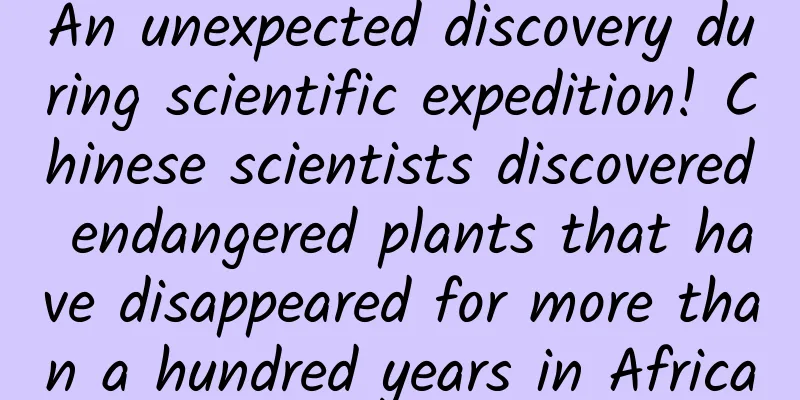An unexpected discovery during scientific expedition! Chinese scientists discovered endangered plants that have disappeared for more than a hundred years in Africa

|
Produced by: Science Popularization China Author: Zhou Yulong (Wuhan Botanical Garden, Chinese Academy of Sciences) Reviewer: Hu Guangwan (Wuhan Botanical Garden, Chinese Academy of Sciences) Producer: China Science Expo Who would have thought that the few small hanging grasses found by the rocks by the scientific expedition team while taking a break after a busy day turned out to be rare plants that had not been discovered for more than a hundred years since the last collection in 1895! This is a story that Hu Guangwan's research team from Wuhan Botanical Garden, Chinese Academy of Sciences, experienced personally. The team rediscovered the rare plant "Acanthus tanara" of the Acanthaceae family in Madagascar, and recently published new results related to it in the international plant taxonomy journal "Phytotaxa". Fairy tales come true? This island is full of surprises! 165 million years ago, due to violent crustal movement, Madagascar Island gradually separated from the African continent, forming the world's fourth largest island located on the southeastern sea of the African continent. Madagascar Island is nearly 1,600 kilometers long, with an average width of about 400 kilometers and a maximum width of more than 570 kilometers. The main features of the island are: a huge central ridge formed by an uplifting rock in the middle, wide in the west and narrow in the east, and a primeval forest belt of more than a thousand kilometers. Isolated from the outside world for hundreds of millions of years, the island's flora and fauna have evolved in a unique way. More than 80% of the species on the island are endemic, with the largest number of unique flora and fauna on Earth, with more than 15,000 endemic species. Currently, there are 91 species of Acanthus plants found on Madagascar, of which 84 are endemic. Justicia tanalensis S. Moore, a rare plant of the genus Justicia L. of the family Acanthaceae, is one of them. Tanara bed Image source: Photographed by the author The central part of Madagascar is a plateau mountain with a tropical plateau climate. This unique landform and climate have created rich biodiversity in the central plateau forests. As of 2010, the Madagascar Catalogue database recorded a total of 14,883 recognized names (64 orders, 243 families, 1,730 genera, 11,220 species and 1,626 subspecies taxa) at all classification levels. Of the 11,220 vascular plants recorded in Madagascar, 10,650 are angiosperms, and the total number of native angiosperm species is 10,319, of which 8,621 are endemic to Madagascar, with a unique rate of 83.5%. There are still many species waiting to be discovered and recorded in this biodiversity hotspot, and the area has extremely high scientific research value and significance. The greatest charm of field expeditions is to explore the unknown world where few people have gone, and to collect and record colorful and fantastic biological species. Beautiful Madagascar (Photo source: Veer Gallery) On the way to scientific research, I "picked up" a treasure In 2019, a joint scientific expedition team organized by the China-Africa Joint Research Center of the Chinese Academy of Sciences conducted a scientific survey of plant diversity in the central plateau of Madagascar. After several hours of trekking, the expedition team finally reached the depths of the Antavolobe Iaroka forest, where there are few signs of human activities. As the plant specimens were collected, the specimen bags gradually became full and heavy. At the same time, the long-term exploration also made the scientific expedition team members gradually tired, so they walked under a damp rock to rest. The scientific expedition team found a few inconspicuous small herbs hanging on the rock, which were initially tentatively identified as Hypoestes viguieri Benoist of the genus Hypoestes. It happened to be the flowering period of these plants. After collecting a few flowering specimens and taking photos of their morphology, the team members continued to explore this treasure trove of plant resources. Later, when the scientific expedition team returned to the research base to process and identify numerous plant specimens, they found that the corollas of these small grasses growing on the rocks can be divided into upper and lower lips. The petals of the upper lip are split into two nearly circular pieces, and the petals of the lower lip are split into thirds. The ones on both sides are circular, and the middle one is nearly elliptical. There is a channel-like structure on the inner surface of the petals of the upper lip, which fixes the style. This flower structure is a characteristic of the genus Acanthus. Through further literature review and specimen comparison, the researchers discovered that the inconspicuous grasses were the "Acanthus tanara", which had not been discovered again for more than a hundred years since the collection records in 1895. Discover the Antavolobe Iaroka Forest in Tanana Image source: Photographed by the author Fill a cup of dew and taste the flavor of nature Acanthus plants have great garden ornamental value because of their rich leaf shapes, bright colors and various flower shapes. Their application forms include flower borders, flower belts and flower clusters, hedges, understory greening and indoor greening. Flower borders are made by using bushes, tree groups, low walls or buildings as backgrounds to simulate the interlaced growth of various flowers on the edge of a forest in nature, creating an irregular, natural landscape. There are many ornamental plants in the Acanthaceae family, such as the flowering plants Justicia betonica and Justicia brandegeeana, and the foliage plants Justicia gendarussa, Justicia ventricosa and Justicia gendarussa 'Silvery Stripe', which are often used in flower borders. Flower belts refer to the planting of various flowers along the road like colorful ribbons, while flower clusters refer to the natural planting method of combining several or more flowers into clusters. Commonly used Acanthus plants in flower belts and flower clusters include Acanthus scabra and Acanthus scabra. Hedges are the most common form of greening in gardens, and can serve as a barrier and enclosure. Asclepiadaceae, Asclepiadaceae, and Asclepiadaceae are evergreen and resistant to pruning and are often used as hedge plants. Plants used for understory and indoor greening are usually shade-tolerant and shade-loving. Most Acanthus plants are shade-loving plants, and are excellent flowers to fill in understory and indoor greening. Justicia procumbens has a pink corolla and a peculiar flower shape that resembles an ancient wine vessel, the jug. The petals have beautiful markings on their lower lip, making it an excellent indoor potted plant. Currently, there is relatively little research on Justicia procumbens, and the unique leaf patterns and lower lip of Justicia procumbens have great research and development potential. Tanara bed Image source: Photographed by the author Over the past decade, the number of existing species in Madagascar listed as threatened (vulnerable, endangered or critically endangered) by the World Conservation Union (IUCN) has increased significantly: in 2010, there were 56 endangered species on the IUCN Red List, 110 in 2015, and 128 in 2021. The scope of this expedition covers the entire central plateau of Madagascar. The researchers found that the Tanara acanthus is only distributed in two forests (Antavolobe Iaroka and Ambohimitombo) on the central plateau, with a number of no more than a hundred plants, and is an endangered species. At the same time, the two forests are facing the threat of bushfires, illegal logging and slash-and-burn farming. The gradual loss of habitat is an important reason for the narrow distribution and scarcity of Tanara Acanthus. Although there are more than 600 species of Acanthus plants in the world, each one carries its unique genetic information and plays its role in its unique ecological niche. On this blue planet, there are still many mysterious and endangered creatures like the Acanthus tanara. If they are not protected, they are very likely to disappear from the earth in the near future and become our eternal regret. Editor: Sun Chenyu References: [1] Mary Summerill. Madagascar. [Z/OL]. A BBC/Animal Planet Co-Production, 2011. https://b23.tv/ep120966 [2] Onjalalaina GE, Jiang H, Rakotonasolo AR, et al. Reappraisal and lectotypification of Justicia tanalensis S. Moore (Acanthaceae), rediscovered from central Madagascar more than 100 years since the last collection[J]. Phytotaxa, 2022, 573(2): 293-300. [3] Niu Zhengyang. Study on chloroplast phylogeny and genomics of Asian Acanthus sensu lato[D]. Nanjing Forestry University, 2020. DOI: 10.27242/d.cnki.gnjlu.2020.000035. [4] Huang Ye, Zhan Weirong, Zhu Jianjun, Weng Zhenxing, Ding Huajiao. The development and utilization value of Acanthaceae plant resources in Zhejiang Province[J]. Flowers and Trees Bonsai (Flower Gardening), 2022(08):78-79. [5] Ding Mingyan, Chen Jian, Lin Shishi. Survey on the diversity of garden plants of Acanthaceae in the Pearl River Delta[J]. Southern Agriculture, 2022, 16(17): 237-240. DOI: 10.19415/j.cnki.1673-890x.2022.17.061. [6] Wu Fei, Cui Yulian, Li Peng, Cui Jingjing, Zhao Meng, Liu Zhiwei, Chen Xu, Hao Yan. Collection and application of Acanthaceae plants[C]//. Proceedings of the 2020 Annual Conference of Chinese Botanical Gardens., 2020: 151-156. DOI: 10.26914/c.cnkihy.2020.064430. [7] Hutchinson J. The Flora of Madagascar[J]. Nature, 1940, 145(3673): 448-451. [8] Michielsen NM, Goodman SM, Soarimalala V, et al. The macroevolutionary impact of recent and imminent mammal extinctions on Madagascar[J]. Nature Communications, 2023, 14(1): 1-15. [9] Callmander MW, Phillipson PB, Schatz GE, et al. The endemic and non-endemic vascular flora of Madagascar updated[J]. Plant Ecology and Evolution, 2011, 144(2): 121-125. (Note: Latin text should be italicized.) |
>>: The "calcium" gang in the nutrition world cannot do without this "military advisor"
Recommend
Hawking passed away. How do brands use copywriting to commemorate his greatness?
When I was very young, I learned about the scient...
There are five levels of operator realm. Which level are you at?
We who practice martial arts... um, no, it's ...
7 essential skills for operations - marketing promotion steps!
A correct marketing promotion process Marketing pr...
A detailed account of the open and covert struggles between Apple and Microsoft over the years
On October 7, Microsoft held a new press conferen...
If you go to Altay, you must see this river
recent Produced by CCTV The TV series "My Al...
How long can a cut watermelon be kept, 1 day, 2 days?
Let me give you the answer first: It is recommend...
Performance is close to Golf R. New generation Hyundai Veloster is about to debut
Recently, Hyundai officially released a set of pr...
The hunting suit market is too competitive. The 2025 Song L EV is fully upgraded with more features but no price increase. It starts at 189,800 yuan.
On August 30, the 2024 Chengdu Auto Show official...
WeChat Pay responds to new payment code regulations: currently in normal use
This evening, the official account "WeChat P...
Samsung vs. Apple: Note 4 has been launched in China, but iPhone 6 is nowhere in sight
Yesterday, Apple announced that iPhone 6/6 Plus w...
Moon: Earthlings, I live much longer than you think!
In the imagination of ancient people Chang'e ...
China Passenger Car Association: Regional market analysis of new energy passenger vehicles in May 2022
According to the new energy vehicle retail data o...
Things about the first releases on the three major channels of BAT, see how the three major first releases are completed in one go!
For small and medium-sized companies, the first r...
[Smart Farmers] Looking at the Wandering Earth from an agricultural perspective: If the Earth were wandering, what would humans eat?
Editor’s Note: The recent hit of "The Wander...









